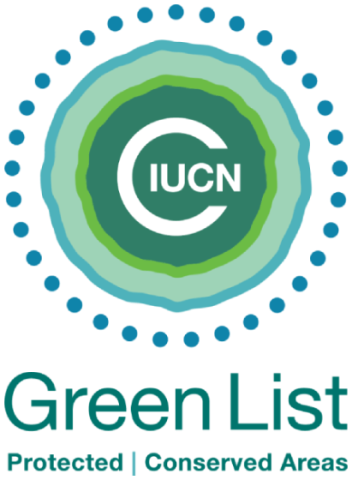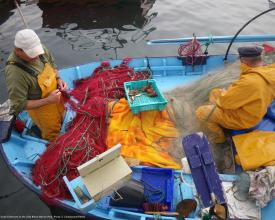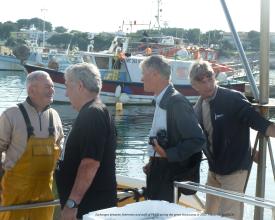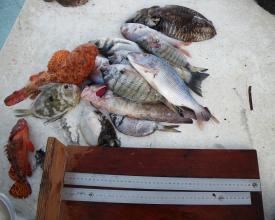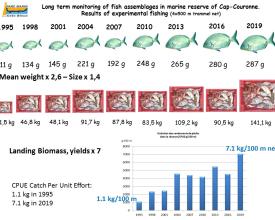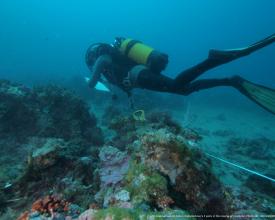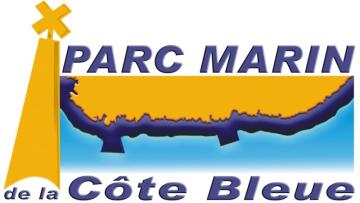
The Cote Bleue Marine Park (France, NW Mediterranean): a success story in co-construction with small scale fisheries since 38 years
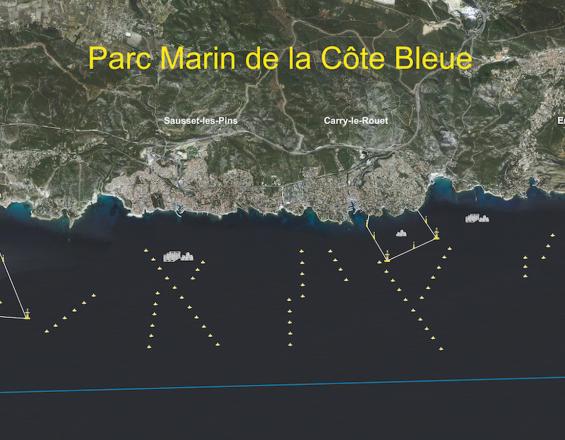
The Cote Bleue Marine Park (PMCB, France) was created in 1983. This bottom up initiative is based on an experimental cooperation between local public authorities and professional small scale fisheries, in order to implement a program for sustainable development of fishing activity, marine environment protection, experimental scientific research and public awareness and education. The territory represent 9.873 ha on 42 km of rocky coastline including 2 no-takes reserves of 295 ha, where all kind of fishing, mooring and scuba diving are prohibited.The originality is the use of no-takes reserves and artificial reefs (both for production purposes and protection against illegal trawling) as a complementary tools for conservation of exploited resources and sensitive habitats.
Context
Challenges addressed
In a global context of fish stock decrease and marine biodiversity and habitats losses, the Cote Bleue Marine Park has been implementing since 1983 the use of no-takes reserves and artificial reefs as complementary tools for protection, restoration and conservation of both exploited resources and sensitive habitats which are the most productive (Posidonia meadows and coralligenous reefs). Challenges are the acceptance of no takes reserve and restoration, both successfully accomplished.
Location
Process
Summary of the process
The 3 building blocks presented interact with each other. The results of a successful management is the combination of the 3 pillars: (i) an accepted MPA (marine Protected Area) with co-construction and shared governance ; (ii) an effective MPA with surveillance and enforcement, long term monitoring and best knowledge of the reserve effects, benefits both for fishes and fishers ; (iii) an adaptive management of MPA is necessary and the PMCB was built on the strengths and weaknesses of local context: artificial reefs have played a role in resolving the antagonisms and conflicts between small-scale fisheries and illegal trawling fisheries.
In the Cote Bleue Marine Park, the two categories of artificial reefs (production and protection reefs) are not dissociable of the two no-takes reserves. These management tools worked in an additional way and contributed to the preservation of traditional small scale fisheries on the Côte Bleue territory, while these fishing activities are decreasing in the nearby zones.
Building Blocks
An accepted Marine Protected Area with shared governance
The PMCB is a local initiative and was founded with a “bottom-up” approach and shared governance. This co-construction is based on strong dialog process since the beginning with local artisanal fishermen organizations. These is around 30-35 small scale fishing boats operating along the coastline, using mainly gillnets and trammel nets. Fishermen are at the origin of the creation of the 2 no-takes reserves (Carry 85 ha since 1983 and Couronne 210 ha since 1996). A real success was the re-conduction of the 2 protected reserves in 2014, obtained for an unlimited time. These no-takes zones have a legal status of fisheries reserves and the renewal was asked by fishermen themselves. The Marine Park has daily contacts with individual fishermen in the 5 small ports of Cote Bleue coastline, through patrol at sea, interviews and monitoring on landing, fishing effort, catches We have also formal but irregular meetings, depending of programs (Natura2000 process, PhD study on fisheries, EU scientific programs).
Enabling factors
Main factor is the willingness of local actors, in particular artisanal fishers. Since the beginning, they collaborate closely with the Park staff on several activities, like monitoring of landings, catches and fishing effort, participation to scientific studies, meetings, exchanges, working with local sea schools. They also give information about poaching on the reserves, abnormal or exceptional phenomena (invasive species like rabbit fish), taking into account sensitive and protected species like the releasing of groupers, signalization of lost nets, etc.
Lesson learned
The social acceptance of Marine Park is a crucial factor, which has conditioned its success. Professional fishermen feel integrated in the decision mechanism and the relationship is based on trust and mutual exchange. Enquiries of social acceptance showed that there is no negative perception of PMCB. The majority of local fishers (88%) feels they are involved in decisions processes of the Park. 69% of fishers sense a positive effect on marine environment and 88% of the fishers perceived a positive effect on the local artisanal fishery. The acceptability is the key of success. Our experience proved the necessity to work above and take into account all the stakeholders concerned (artisanal fishers, representatives of cities, local, regional and State administration, inhabitants) for marine management measures.
Better knowledge for better management
The protection and surveillance within the 2 no-take reserves -where all kind of fishing, mooring and scuba diving are prohibited- is effective, with more than 2.400 hours of enforcement per year, mostly at sea, There is a great increase in fish biomass with an increase of abundance, more bigger fishes, and come back of rare/sensitive species like groupers, brown meagre, seabass, etc: Experimental controlled fishing operations are conducted every 3 years within the reserve and showed that in 24 years, the mean weight of a fish increased by a factor of 2.6 (287 g in 2019 vs. 111 g in 1995. During this time, fishing captures have been multiplied by a factor of 7, with a catch rate per CPUE effort unit increasing from 1.1 kg / 100 m of net in 1995 to a maximum of 7.1 kg / 100 m in 2019 (Figure 2).
These spectacular results and a clear reserve effect not only concern fishes, but also the invertebrates like spiny lobsters: catches were multiplicated per 8 since the creation of the reserve. These results are important for artisanal fishers who benefits to biomass exportation processes: in the borders of marine reserves, the fishing yields can reach 2.5 kg/100 m of net; while in the rest of MPA, the mean CPUE is 1kg/100 m.
Enabling factors
Willingness and involvement of local artisanal fishers who decided themselves to create a second no-take reserve in PMCB in 1996 (Couronne, 210 ha), after the previous one in Carry (1983, 85 ha).The same fishing boat (“Mamyblue”) participate since the beginning to experimental fishing conducted every 3 years and fishers can see directly in the fish box the reserve effect when they bring back their nets, with a multiplication par 7 of catches (141 kg in 2019 vs 21 kg in 1995)
Lesson learned
Long term monitoring showed a clear reserve effect with more fishes in abundance, more bigger and the return of rare species. Surveillance and enforcement is the keystone of a good management of no-take reserve. Nature can recreate biodiversity and restore by herself we need to help and take care of her, it’s our responsibility Even 6% of the Mediterranean Sea is covered by Marine Protected Areas, there is only 0.23% that is fully or highly protected. Less than a quarter of 1%, it’s really not enough! Marine Protected Areas are not only technical solutions, but also human relationships take into account, and history and culture of a territory, with a common vision.
No-take reserves worked well, even small superficies under full protection can restore biodiversity and resources. Necessity to realize scientific monitoring on a long period of time, for a better knowledge of reserve effect, with a BACI protocole (before/after/control/impact).
Back to some successful management
Apart from creation of 2 no-takes reserves, the originality of PMCB is the use of artificial reefs, with the deployment of 4.884 m3, both for production and protection against illegal trawling. The success of protection reefs is showed on Figure 3, with the road of illegal trawling plotted before (1995) and after reef deployment and creation of the no-take reserve in Couronne (1997). The results are the decreasing of fishing pressure on the coastal band, by removal illegal trawling activities, witch are not selective (a lot of juveniles are caught) and mortality by fishing juveniles is the principal factor of the falling of catches. The efficiency of anti-trawling reefs allowed a better sharing of space and resources between local fishermen. It help traditional small scale fisheries (gillnet, trammel net, hook on line) who have selective techniques (catch only adults and thus facilitating conservation of fishing resources) The other essential effect of protection reefs is to preserve the most productive and fragile natural habitats (Posidonia meadows and coralligenous reefs) from mechanical destruction by trawlers. These damages have important ecological and economic repercussions, because these habitats serving for spawning, nurseries, recruitment and feeding areas for the most part of the exploited resources.
Enabling factors
The willingness of local artisanal small-scale fishers to avoid illegal trawling into the 3 NM, in particular on sensitive habitats. Fishers decided themselves to create a second no-take reserve in PMCB in 1996: Couronne (210 ha), who is in vicinity of a Cape, with high biodiversity and rich exploited resources, particularly a famous spawning area for seabass during winter. Fishers wanted to protect the no-take reserve with a complementary deployment of anti-trawling reefs around and inside the reserve.
Lesson learned
An adaptive management is necessary and the PMCB was built on the strengths and weaknesses of local context: artificial reefs have played a role in resolving the antagonisms and conflicts between small-scale fisheries and illegal trawling fisheries.
In the Côte Bleue Marine Park, the two categories of artificial reefs (production and protection reefs) are not dissociable of the two no-takes reserves. These management tools worked in an additional way and contributed to the preservation of the traditional small scale fisheries on the Côte Bleue territory, while these fishing activities are decreasing in the nearby zones.
Artificial reefs worked well and protection reefs played a police role 24h/24 and the deployment of 326 heavy modules creating 17.5 km of barriers allows to reduce illegal fishing, protect natural sensitive habitats and permits a better sharing of space and resources between fisheries.
Impacts
The experiments of management conducted by the Cote Bleue Marine Park since 38 years led to positives impacts: (i) environmental impact with a clear reserve effect observed with more fishes, more bigger and the return of rare and protected species. In 24 years, the fishing captures have been multiplied by a factor of 7 and the mean weight of a fish increased by a factor of 2.6 ; (ii) social impact with an acceptation of Park and marine reserves by local artisanal fishers (88% feels they are involved in decisions process of the Park) who are at the origins of creation of no-takes reserves and artificial reefs, and who benefits directly or indirectly of these protection tools ; (iii) and economic impact, local fisheries getting more sustainable, with high catches CPUE around the borders of no-take reserves (2.5 kg/100 m of net vs. 1 kg/100 m in the rest of PMCB).
Beneficiaries
Main beneficiaries are both fish and fishers, as well as all local inhabitants of Cote Bleue, given the Marine Park is a tool which allows a global preservation (environmental, economic and patrimonial)
Sustainable Development Goals
Story
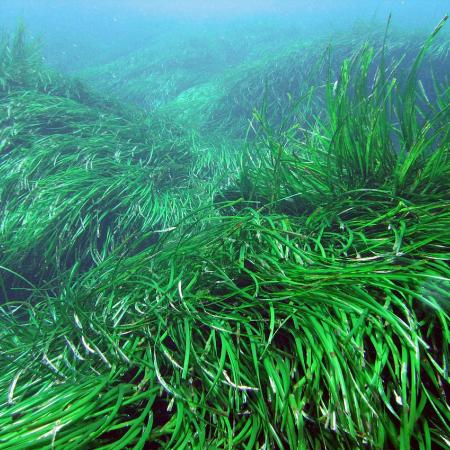
The Cote Bleue Marine Park (PMCB, France) was created in 1983. It’s based on an experimental cooperation between local public authorities and professional small scale fisheries in order to implement a program for sustainable development of fishing activity, marine environment protection, experimental research and public awareness. The territory represent 9.873 ha on 42 km of rocky coastline including 2 no-takes reserves of 295 ha, where all kind of fishing, mooring and scuba diving are prohibited.The originality is the use of no-takes reserves and artificial reefs as a complementary tools for conservation of resources and habitats. There is about 4.884 m3 of artificial reefs, both for production purposes and protection from illegal trawling inside the 3NM, around 17.5 km of barriers of protection reefs. The Park is a local initiative and was founded with a “bottom-up” approach. This co-construction is based on strong dialog process with local professional fishermen organizations. That’s one of the main benefits that the PMCB offers. The association of local fishers within the PMCB's decision body is truly effective, and the Marine Park is composed of local (mayors of the 5 villages), regional and departmental elected representatives The PMCB is a “sea-life size laboratory” and conduct several programs of applied research and scientific studies. It’ permittes to have strong references in scientific litterature,particularly on the "reserve effect", with around forty five scientific monitoring, like fish visual census, sea-urchins, red coral, Posidonia meadow, frequentation, etc. Since its origin, the Park also created awareness and educational programs for scholars, with the implementation of one week of field training course. More than 28 000 children made aware about the marine environment. There is an underwater pathway in the no-take reserve of Carry for public and tourists. Since 1994 PMCB organize free visits by snorkeling 3 days per week during every summer. Visitors can see the reserve effect with really more bigger fishes. Finally, the Côte Bleue Marine Park received an international recognition for an outstanding MPA management efficiency with the label “Green List” of Protected Areas delivered by IUCN, and the SPAMI (Specially Protected Area of Mediterranean Importance) label in 2012 and inclusion in European Natura 2000 network since 2009 (site “Côte Bleue Marine” of 18 928 ha). A real success for this small team (8 employees) and local initiative.
